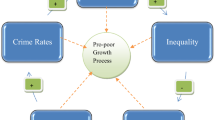Abstract
This study presents a model of income evolution from which dynamic versions of commonly used static poverty measures are derived. The dynamic indexes are calculated both for finite- and infinite-size economic systems. Probabilistic convergence results prove that the infinite-size system can be conveniently used to approximate the finite-size system in an effective way. Secondly, poverty indexes estimation based on micro-data are discussed under different sampling schemes and it is proved that they are strongly consistent. A hypothetical example is used to show the dynamic evolution of the poverty and the estimation methodologies.
Similar content being viewed by others
References
Annoni, P., Bruggemann, R. and Carlsen, L. (2015). A multidimensional view on poverty in the European Union by partial order theory. J. Appl. Stat. 42, 3, 535–554.
Arenbaev, N.K. (1976). Asymptotic behavior of the multinomial distribution. Theor. Veroyatn. Primen. 21, 805–810.
Bane, M.J. and Ellwood, D.T. (1986). Slipping into and out of poverty: the dynamics of spells. J. Human Resources 21, 1–23.
Bladt, M. and Sørensen, M. (2005). Statistical inference for discretely observed Markov jump processes. J. Roy. Statist. Soc. B67, 395–410.
Breen, R. and Moisio, P. (2004). Poverty dynamics corrected for measurement error. J. Econ. Inequality 2, 171–191.
Cappellari, L. and Jenkins, S.P. (2004). Modelling low income transitions. J. Appl. Econom. 19, 5, 593–610.
Chiquet, J. and Limnios, N. (2006). Estimating stochastic dynamical systems driven by a continuous-time jump Markov process. Methodol. Comput. Appl. Probab. 8, 431–447.
Crommelin, D. and Vanden-Eijnden, E. (2009). Data-based inference of generators for Markov Jump processes using convex optimization. Multiscale Model Simul. 7, 1751–1778.
Culver, W.J. (1966). On the existence and uniqueness of the real logarithm of a matrix. Proc. Am. Math. Soc. 17, 1146–1151.
D’Amico, G., Di Biase, G. and Manca, R. (2012). Income inequality dynamic measurement of Markov models: application to some European countries. Econom. Modelling 29, 1598–1602.
D’Amico, G., Di Biase, G. and Manca, R. (2014). Decomposition of the population dynamic theil’s entropy and its application to four european countries. Hitotsubashi J. Econom. 55, 2, 229–239.
Duncan, G.J., Gustafsson, B., Hauser, R., Schmaus, G., Messinger, H., Muffels, R.J.A., Nolan, B. and Ray, J.-C. (1993). Poverty dynamics in eight countries. J. Popul. Econom. 6, 215–234.
Formby, J.P., Smith, J.W. and Zheng, B. (2004). Mobility measurement, transition matrices and statistical inference. J. Econ. 120, 181–205.
Gini, C. (1912). Variabilitá E Mutabilitá. Contributo Allo Studio Delle Distribuzioni E Delle Relazioni Statistiche. C. Cuppini, Bologna.
Karr, A.E. (1991). Point Processes and Their Statistical Inference, 2nd edn. CRC Press, Boca Raton.
Langeheine, R. and van de Pol, F. (1990). A unifying framework for Markov modelling in discrete space and discrete time. Sociological Methods Res. 18, 416–441.
Lee, N., Ridder, G. and Strauss, J. (2017). Estimation of poverty transition matrices with noisy data. J. Appl. Econom. 32, 1, 37–55.
McCall, J.J. (1971). A Markovian model of income dynamics. J. Am. Stat. Assoc. 66, 335, 439–447.
McClean, S.I. (1980). A semi-Markov model for a multigrade population with Poisson recruitment. J. Appl. Probab. 17, 846–852.
McDonald, D.R. (1980). On the poisson approximation to the multinomial distribution. Can. J. Stat. 8, 1, 115–118.
Osberg, L. and Xu, K. (1999). Poverty intensity: how well do canadian provinces compare?. Can. Public Policy 25, 2, 179–195.
Quah, D. (1996). Empiric for economic growth and convergence. Eur. Econom. Rev. 40, 951–958.
Regnault, P. (2012). Entropy estimation of M/M/1 queueing systems. In Bayesian Inference and Maximum Entropy Methods in Science and Engineering, AIP Conference Proceedings. P. Goyal, A. Giffin, K.H. Knuth, E. Vrscay, (eds.). American Institute of Physics, Melville vol. 1443, pp. 330–337.
Regnault, P. (2014). Confidence intervals for dynamic Theil’s entropy of economic systems modeled by birth-death processes. In New Perspectives on Stochastic Modeling and Data Analysis. J. Bozeman, V. Girardin, C.H. Skiadas, (eds.). ISAST, Athens.
Sen, A. (1976). Poverty: an ordinal approach to measurement. Econometrica 44, 2, 219–231.
Shorrocks, A.F. (1995). Revisiting the sen poverty index. Econometrica 63, 5, 1225–1230.
Takayama, N. (1979). Poverty, income inequality, and their measures: Professor Sen’s axiomatic approach reconsidered. Econometrica 47, 3, 747–759.
Vassiliou, P.-C.G. and Papadopoulou, A. (1992). Non-homogeneous semi-Markov systems and maintainability of the state sizes. J. Appl. Probab. 29, 519–534.
Whelan, C.T., Layte, R., Maître, B. and Nolan, B. (2000). Poverty dynamics: an analysis of the 1994 and 1995 waves of the European community household panel. Eur. Societies 2, 4, 505–531.
Author information
Authors and Affiliations
Corresponding author
Rights and permissions
About this article
Cite this article
D’Amico, G., Regnault, P. Dynamic Measurement of Poverty: Modeling and Estimation. Sankhya B 80, 305–340 (2018). https://doi.org/10.1007/s13571-018-0153-6
Received:
Published:
Issue Date:
DOI: https://doi.org/10.1007/s13571-018-0153-6




